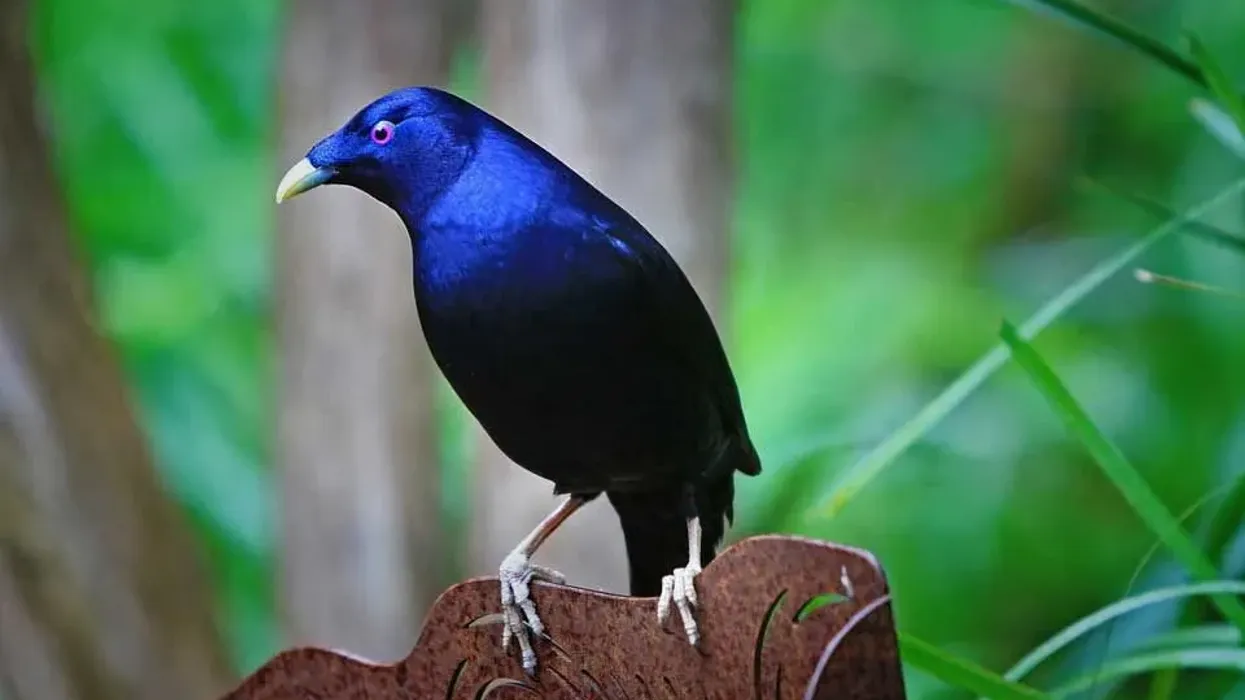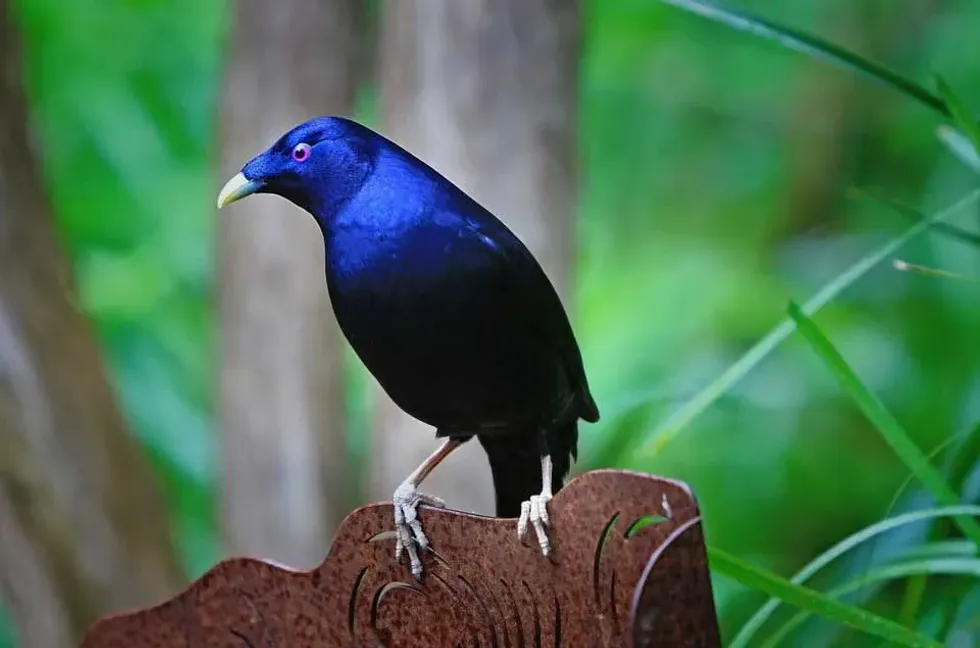The satin bowerbird is a stunning bird in the world that inhabits Australia and New Guinea. The satin bowerbird, (Ptilonorhynchus violaceus) inhabits forests and woodlands mainly in the south-east and east coast of Australia.
The adult male, as well as female satin bowerbirds, have only one similarity. Both of them possess eyes of beautiful bright lilac-blue color. The male satin bowerbird is mainly black-colored and possesses a glossy indigo-blue sheen, whereas the female is nothing alike, having an olive-green colored upperside along with dark and off-white colored scalloping on her underside.
Female satin bowerbird has brown wings and tail feathers. The bill can be black or brown.
The juvenile male and female do look similar and are both referred to as the green birds. Bowerbirds are believed to be a very advanced species, also known as 'Extraordinary engineers'. Why are satin bowerbirds called so?
Because of the bowers, they construct. Males weave complicated and detailed display areas, known as bowers.
These bowers are made out of twigs and sticks. The bower is decorated with charcoal, saliva, flowers, and colorful objects.
It is an attractive avenue that is used to entice females by the mature males to engage in mating. The unique bower is the origin of the common name of this species of bird. The diet of this multi-colored species includes flowers, fruits, seeds, nectar, and leaves.
They feed upon insects as well, but only in the breeding season. Keep reading to get to know more about the satin bowerbird biology including satin bowerbird mating facts, satin bowerbird nest facts, and much more!
If you enjoyed reading our satin bowerbird interesting facts, you will surely find our bowerbird surprising facts and flame bowerbird fun facts extremely captivating!
Satin Bowerbird Interesting Facts
What type of animal is a satin bowerbird?
The satin bowerbird is a bowerbird species that is a close relative of the birds of paradise.
What class of animal does a satin bowerbird belong to?
The beautiful satin bowerbird belongs to the class of Aves
How many satin bowerbirds are there in the world?
The population of the satin bowerbirds of Australia has not been evaluated yet. But their population trend is decreasing as per the IUCN.
Where does a satin bowerbird live?
These birds of Australia inhabit forests and woodlands of Australia's east and south-east coast, which are quite humid. They are observed towards Victoria starting from southern Queensland. They are also present in North Queensland's Wet Tropics.
They can also be spotted in open regions that are nearby their typical habitat. They fly over to open habitats in flocks during the winter season like parks, orchards, and gardens. Their bower site is typically in woodlands or rainforests.
What is a satin bowerbird's habitat?
These birds inhabiting the east and south-east coast of Australia live in their bower that is made by the males, out of sticks and twigs. The bower is built by mature as well as immature male bowers.
The sticks run south from north and are woven into walls. The bower is decorated with blue objects like berries, feathers, and flowers, with the sole purpose of luring females.
They might also use plastic material such as clothes pegs to decorate their bower if they are living near humans.
The male birds also steal from the bower of other males or destroy it. The male mixes saliva with plant material so as to create and paint for the bower's walls.
As their bower, the male bowerbirds can construct teepeelike constructions that can be as long as 9 ft (2.7 m)! During the winter season, which is not their breeding season, the bowerbirds fly to the wider countryside flying by orchards as well.
Who do satin bowerbirds live with?
Male satin bowerbirds are solitary mostly. The green birds, (juveniles) can be spotted in large flocks or groups. The male is not even interested in sharing nesting duties. The female satin bowerbirds take up that responsibility.
How long does a satin bowerbird live?
Satin bowerbird lifespan is the longest of all passerine birds. It can live for 8-9 years, with the highest recorded lifespan being 26 years, which is the longest out of the lifespans of all passerine birds. Comparatively, the common raven, the heaviest-known passerine bird, which has notable banding records, has not managed to live further than 21 years.
How do they reproduce?
The striking satin bowerbirds of Australia are polygonous. The male can mate with many females during the breeding season which starts in October and lasts till February.
The male constructs and decorates a bower that is a part of their display and is built for the sole purpose of attracting females and mate with them.
The satin bowerbird bower is an avenue constructed from sticks and twigs that run south from north and are woven into walls. The platforms are decorated elaborately by the male bowerbirds with mainly blue-colored objects, like berries, feathers, snail shells, and flowers.
The satin bowerbird courtship begins at the arrival of the female which includes a display of strutting and prancing near the bower. The male will hiss, scold, and chatter while offering the female satin bowerbirds objects that he has collected.
The female will walk into the bower if she is impressed by the male. She will solely perform all nesting duties.
After the couple mates, the female will construct a nest in a tree or bush, that is of a shallow cup shape that is also made out of twigs and sticks. Here she will lay one to three eggs that are a paler shade of brown and possess dark markings.
Their incubation period goes on for three weeks. The newly hatched chicks leave the nest after 17-21 days.
However, they are dependent on their mother for food for few weeks. The male juveniles reach reproductive maturity at seven years of age after they have achieved their blue-black adult plumage, whereas the females that are mainly green-brownish in color, become active 2-3 years after birth.
What is their conservation status?
The conservation status of the satin bowerbirds is 'Least Concern' as per the IUCN's Red List. These birds aren't endangered yet. However, they are facing habitat loss due to fragmentation and deforestation, which is leading to their population trend decreasing.
Satin Bowerbird Fun Facts
What do satin bowerbirds look like?
The beautiful blue satin bowerbird has a striking appearance, especially the male satin bowerbird whose indigo-blue sheen is similar to that of the common grackles. It has a short bill and is a plump bird.
The adult male, as well as female satin bowerbird, have only one similarity. Both of them possess eyes of beautiful bright lilac-blue color.
The male satin bowerbird plumage is mainly black-colored and possesses a glossy indigo-blue sheen, whereas the female is nothing alike, having an olive-green colored upperside along with dark and off-white colored scalloping on her underside. Female satin bowerbird has brown wings and tail feathers.
The bill can be black, brownish, or pale greenish-yellow. The juvenile male and female do look similar and are both referred to as the green birds.
Its feet and legs are of a pale shade of pink. Their chick possesses a brownish and greenish colored plumage that is similar to that of females till the age of three.

How cute are they?
The satin bowerbirds are quite cute. Males have brighter colors that are more dazzling than the females.
How do they communicate?
The satin bowerbird sound is very noisy when it's not their breeding season. The satin bowerbird calls are much more noticeable when they are in flocks. They emit a range of sounds like hissing, whistling, and buzzing. The males produce a noisy 'Weooo' sound.
How big is a satin bowerbird?
These birds range between 12.6-12.9 in (32-33 cm) in length, which is almost two times the length of the western wood pewee!
How fast can a satin bowerbird fly?
The satin bowerbird has a rapid flight, going from tree to tree. It flies clearly over treetops with an undulating flight when flying in a flock.
How much does a satin bowerbird weigh?
These birds weigh between the range of 6-10.2 oz (170-290 g).
What are the male and female names of the species?
There are no particular names for the females and males of this bowerbird species.
What would you call a baby satin bowerbird?
The babies of these birds are known as chicks at birth.
What do they eat?
Satin bowerbirds are a diurnal species that search for food everywhere, mainly feeding on fruits. They forage in flocks of about 200 birds during the winter season.
The satin bowerbird diet comprises flowers, fruits, seeds, nectar, and leaves. They feed upon insects as well, but only in the breeding season. Raptors, goshawks, and kookaburras prey on the nest of bowerbirds.
Are they dangerous?
No, these birds are not dangerous.
Would they make a good pet?
As much as beautiful these Australian birds are, they are wild birds, and won't make great pets.
Did you know...
The male bowerbird that possesses the dullest of the plumage constructs the most intricate of bowers.
Why are they called bowerbirds?
Males weave complicated and detailed display areas, known as bowers. These bowers are made out of twigs and sticks and the male carries out its courtship displays around it.
The bower is decorated with charcoal, saliva, flowers, pebbles, snail shells, and colorful objects. It is an attractive avenue that is used to entice females by the mature males to engage in mating. The unique bower is the origin of the common name of this species of bird.
Why do satin bowerbirds collect blue?
The males choose bright blue objects like clothes pegs to decorate their bower blue as their plumage is also a shade of bright blue and similar colored articles accentuate their plumage color.
Here at Kidadl, we have carefully created lots of interesting family-friendly animal facts for everyone to discover! For more relatable content, check out these giant cowbird surprising facts and grebe fun facts pages!
You can even occupy yourself at home by coloring in one of our free printable satin bowerbird coloring pages!









